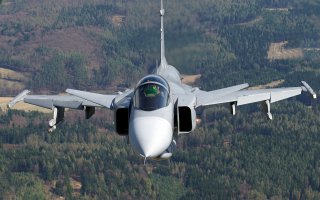Meet the JAS-39 Gripen: Sweden’s Affordable Alternative to F-35
The Gripen has seen considerable success replacing aging fighters in former Warsaw Pact countries, and has also seen sales in Africa, the Americas and Asia.
Here's What You Need to Know: Sweden has a mjaor export success on its hands.
The JAS-39 Gripen is the Swedish defense industry’s largest export, financially. The Gripen has seen considerable success replacing aging fighters in former Warsaw Pact countries, and has also seen sales in Africa, the Americas and Asia. But why is the Gripen successful on the export market? How does it stack up against other NATO products and Russian jets?
The primary European export success for the Gripen is in post-Soviet states. This is probably due to the accession of these states into NATO and the subsequent need to field “NATO compatible” aircraft at an affordable price. Other European nations either field their own modern jets like the Eurofighter Typhoon, or procured American designs such as the F-16 prior to the fall of the Warsaw Pact, and thus are not really in need of a new jet (although the Gripen NG might fill a niche here).
In the post-Soviet states, a common thread is the replacement of the MiG-29 as a fighter aircraft. While the MiG-29 as evaluated by the U.S. Air Force and postreunification Luftwaffe to be a competent “knife-fight” dogfighter, it was considered to be lacking when it came to independent intercept and beyond-visual-range capability. Practically every Warsaw Pact state operated these aircraft as their front-line fighters, with the Soviet Union reserving the more advanced Su-27S “Flanker” aircraft for themselves. Thus, the MiG-29 quickly became obsolete in the air forces of Poland, Hungary, Czechia, Slovakia and Bulgaria, necessitating a replacement. The Hungarian Air Force decided to acquire Gripens in 2003, with Czechia following in 2005. Slovakia is finally replacing their MiGs in 2018, with the decision down to the Gripen or the F-16. The F-16 is said to be more expensive. Bulgaria is in a similar situation, with the Eurofighter and F/A-18 also in consideration. Poland decided to acquire F-16s instead, probably due to their close relations with the United States. For small European countries on a budget, the Gripen makes a lot of sense. Due to the smaller area of patrol, a dual-engine design is not as necessary as it is in Finland or Canada (both of which operate F/A-18s, a dual-engine design). The lower combat range and external stores are less of an issue, as aircraft can be expected to rapidly return to their home bases to rearm.
Also, the Gripen has relatively modern radars and navigation systems compared to the MiG and has integration with export-cleared American missiles (in the C and D “export-ready” variants). Probably one of the largest factors for Gripen adoption is the very low flight hour cost. Gripens were rated by Jane’s to have a cost of around $4700 per flight hour. Next cheapest was the F-16 at $7000 per flight hour. Other European designs and the F/A-18 go over $10,000 per flight hour. Given that the MiG-29 has flight hour cost of around $4500 per flight hour, the Gripen is a logical choice to keep sustainment budgets from growing too much relative to past jets.
Conversely, the other major export success for the Gripen has been replacing Cold War American jets. Both Brazil and Thailand have acquired the Gripen to replace their fleets of F-5 fighter jets. While Thailand also operates the F-16A and B, they operated these aircraft alongside their F-5 fleet and bought the Gripens to replace their F-5s. Likewise, Brazil bought Gripens to also replace their F-5s. South Africa also operates Gripens, but they replaced aging French Mirage F1AZs and indigenous Mirage III upgrades as opposed to American aircraft. Either way, the trend is clear, when countries wanted to have a cheap, short-ranged, but effective patrol fighter to replace aging Cold War designs that were beyond modernization, the Gripen was chosen.
The Gripen is not without its problems. While the NG Gripen has an AESA radar, the standard pulse-doppler radar in the older C and D variant has middle-of-the-pack performance. It also has a relatively poor thrust to weight ratio. The single RM-12 engine puts out 18k lbs of thrust with afterburner and 12k without. Given that the Gripen weighs 15k without any armament, a loaded Gripen would be less nimble and suffer from performance issues relative to American or Soviet fighters, both of which tend to have high thrust to weight ratios.
Charlie Gao studied political and computer science at Grinnell College and is a frequent commentator on defense and national-security issues.
This article first appeared in 2018.
Image: Milan Nykodym / Wikimedia Commons

